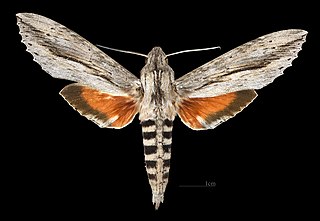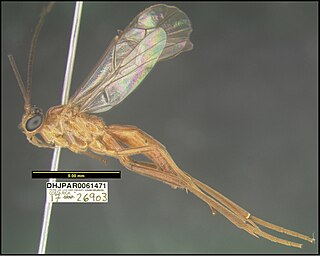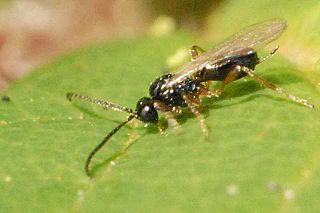
In evolutionary ecology, a parasitoid is an organism that lives in close association with its host at the host's expense, eventually resulting in the death of the host. Parasitoidism is one of six major evolutionary strategies within parasitism, distinguished by the fatal prognosis for the host, which makes the strategy close to predation.

Sawflies are wasp-like insects that are in the suborder Symphyta within the order Hymenoptera, alongside ants, bees, and wasps. The common name comes from the saw-like appearance of the ovipositor, which the females use to cut into the plants where they lay their eggs. The name is associated especially with the Tenthredinoidea, by far the largest superfamily in the suborder, with about 7,000 known species; in the entire suborder, there are 8,000 described species in more than 800 genera. Symphyta is paraphyletic, consisting of several basal groups within the order Hymenoptera, each one rooted inside the previous group, ending with the Apocrita which are not sawflies.

The superfamily Ichneumonoidea contains one extinct and three extant families, including the two largest families within Hymenoptera: Ichneumonidae and Braconidae. The group is thought to contain as many as 100,000 species, many of which have not yet been described. Like other parasitoid wasps, they were long placed in the "Parasitica", variously considered as an infraorder or an unranked clade, now known to be paraphyletic.

The Ichneumonidae, also known as ichneumon wasps, ichneumonid wasps, ichneumonids, or Darwin wasps, are a family of parasitoid wasps of the insect order Hymenoptera. They are one of the most diverse groups within the Hymenoptera with roughly 25,000 species described as of 2016. However, this likely represents less than a quarter of their true richness as reliable estimates are lacking, along with much of the most basic knowledge about their ecology, distribution, and evolution. It is estimated that there are more species in this family than there are species of birds and mammals combined. Ichneumonid wasps, with very few exceptions, attack the immature stages of holometabolous insects and spiders, eventually killing their hosts. They thus fulfill an important role as regulators of insect populations, both in natural and semi-natural systems, making them promising agents for biological control.

The Braconidae are a family of parasitoid wasps. After the closely related Ichneumonidae, braconids make up the second-largest family in the order Hymenoptera, with about 17,000 recognized species and many thousands more undescribed. One analysis estimated a total between 30,000 and 50,000, and another provided a narrower estimate between 42,000 and 43,000 species.

Erinnyis ello, the ello sphinx, is a moth of the family Sphingidae. The species was first described by Carl Linnaeus in his 1758 10th edition of Systema Naturae. It is distributed from Argentina through Central America to the United States as far north as Nevada.

Parasitoid wasps are a large group of hymenopteran superfamilies, with all but the wood wasps (Orussoidea) being in the wasp-waisted Apocrita. As parasitoids, they lay their eggs on or in the bodies of other arthropods, sooner or later causing the death of these hosts. Different species specialise in hosts from different insect orders, most often Lepidoptera, though some select beetles, flies, or bugs; the spider wasps (Pompilidae) exclusively attack spiders.

The Aphidiinae are a subfamily of tiny parasitoid wasps that use aphids as their hosts. Several species have been used in biological control programs of various aphids.

Microgastrinae is a subfamily of braconid wasps, encompassing almost 3,000 described species, with an estimated 30,000–50,000 total species. This makes it one of the richest subfamilies with the most species of parasitoid wasps.

Cotesia is a genus of braconid wasps first described by Peter Cameron in 1891. Some species parasitize caterpillars of species considered pests, and are used as biocontrol agents. Cotesia congregata parasitizes the tomato and the tobacco hornworms. C. glomerata and C. rubecula feed on the cabbage white and other white butterfly caterpillars. C. gonopterygis and C. risilis are host-specific and parasitize the common brimstone.

The Braconinae are a large subfamily of braconid parasitoid wasps with more than 2,000 described species. Many species, including Bracon brevicornis, have been used in biocontrol programs.

The Opiinae are a subfamily of braconid parasitoid wasps with over 1300 described species. Several species have been used in biocontrol programs against fruit flies and Agromyzidae flies. They are closely related to the Alysiinae.

The Cenocoeliinae are a subfamily of braconid parasitoid wasps.
Apozyx is a genus of braconid parasitic wasps with only one species, Apozyx penyai. It is the only genus in the subfamily Apozyginae. This subfamily was originally proposed as a separate family by Mason in 1978.
The Cardiochilinae are a subfamily of braconid parasitoid wasps. This subfamily has been treated as a tribe of Microgastrinae in the past. Some species including Toxoneuron nigriceps have been used in biocontrol programs.

The Homolobinae are a subfamily of braconid parasitoid wasps.
Dirrhope is the only extant genus in the subfamily Dirrhopinae of braconid parasitoid wasps. Dirrope was included in the Microgastrinae until 1984. Specimens of this genus have been found fossilsed in amber dating from the Cretaceous period.

Blacini is a tribe of braconid Parasitoid wasps.

Lysiphlebus testaceipes is a species of small braconid parasitoid wasp in the subfamily Aphidiinae. L. testaceipes can utilize numerous species of aphids as hosts and has often been used as a biological control agent against aphid pests. It is considered an invasive species in several European countries.
The Acampsohelconinae are a subfamily of braconid parasitoid wasps. Extant members of this subfamily were previously included in the Helconinae, Blacinae, or Sigalphinae. The four genera included are †Acampsohelcon, Afrocampsis, Canalicephalus, and Urosigalphus.















